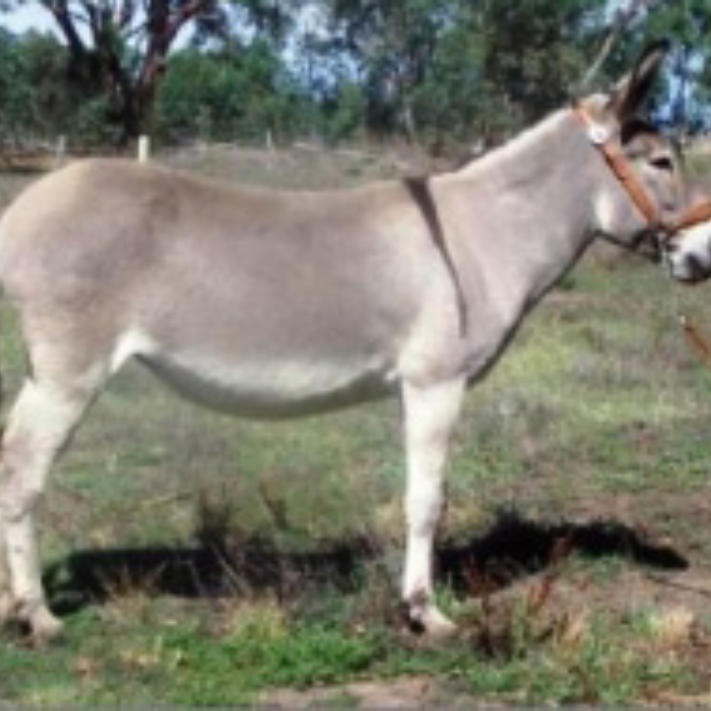The Australian Teamster developed over 150 years of isolation in the arid regions of Australia. They are an excellent medium sized Donkey, the name giving recognition to their original purpose. Many breeders based their studs solely on the descendants of the original team Donkeys found in outback, for reasons of preference of style/size, also for their historical and heritage links.
Far from being a work animal, the Teamster now is usually found as a recreational animal for harness, under saddle or pack, in the show ring and as a devoted companion.
In 2005 the name "Australian Teamster” was coined by what was then the EIDSA All Breeds Inc., as an apt and accurate term for the Teamster Donkeys’ type, style and historic origins. The first register for them was formalised, recognising them formally as a Breed.
The creation of the “Australian Teamster” Register has been quickly accepted, and it has joined the heritage equines breeds of Australia.
Today there are two sections for the Australian Teamster Donkey:
Teamster A
No known outcrosses to English, Irish, or Miniature. Has some providence that links it to original origins, (eg. from breeders stud stock or station stock).
Teamster B
No known outcrosses to English, Irish, or Miniature. If no known providence, inspection required.
Allowable outcrosses of up to 25% of any of the other recorded Breeds used in its early development - such as Andalusian, American Mammoth Jackstock Poitou.
Background
The Australian Donkey had long been regarded as a donkey defined not only by appearance but by its links to Australia’s early settlement and transport history.
In 2005 the name "Australian Teamster” was coined by the then EIDSA All Breeds Inc. as an apt and accurate term for the Teamster Donkeys’ type, style and historic origins .The first register for them was formalised, resulting in the them being recognised as a breed.
The creation of the “Australian Teamster” Register has been quickly accepted, and it has joined the heritage Equine breeds of Australia.
The New Zealand Donkey and Mules Society have also accepted and created a Teamster register for their own Australian Donkeys in New Zealand.
History
The Australian Teamster developed over 150 years of isolation in the arid regions of Australia into an excellent medium sized Donkey, and its name gives recognition to their original purpose.
Many breeders based their studs solely on the descendants of the original team Donkeys found in outback, for reasons of preference of style or size, also, importantly, for their historical and heritage links.
Far from being a work animal, the Teamster now is usually found as a recreational animal for harness, under saddle or pack, in the show ring, and as a devoted companion.
The Teamster's Donkeys were derived from the hardiest of the world's large working Donkeys. It is quite logical that they would have been first sourced from countries with hot climates on the shipping routes of the time. From what can be gathered, first Donkeys came from places on the shipping route such as India, Rarwapindi, Chile, Capetown etc.
The Donkeys used in teams in Australia generally needed to be of a large standard size.
Around the late 1800's there are records of specific breeds being brought to Australia. These include Andalusian, Maltese, and the American Jackstock. Many documented imports exist of American Jackstock up to 15 hh. One of these Jacks had offspring shown as early as 1881 at Sydney Show. The last known import of these large Donkeys was in 1935.
Old photos show the influence of these imports in many teams, and still today, many reflect Andalusian blood in the coat colour, heads and dapples or roaning. Also the black and occasional red influence of the American Jackstock.
The home of the working team Donkey was to be the remote arid inland of Australia. The donkey, being more tolerant of harsh conditions than horse & bullock teams, supplied the remote outstations and settlements,
The Donkeys’ staunchness in harness, and his propensity to stay close to the wagon, not straying far, were qualities the teamsters, (the 'driver'), valued.
Another attribute which made Donkeys and Mules indispensable was the ‘immunity’ they had to "Kimberly Walk-About Disease" - a fatal condition caused by ingestion of a poison weed. The Donkeys either avoided or were immune to its effects.
The Donkey is essentially a desert animal, he has a more efficient use of both feed and water than a horse, and the "cooling system" includes fat deposits that act as to insulate. Donkeys produce less moisture in dung, can dehydrate to a level that would kill a horse, and then take back in only enough water to exactly replenish normal hydration levels.
The Donkey teams were large, up to 4 or 5 abreast, and commonly 20 to 40 or more, per team. They were driven by voice alone, the teamster walking alongside. One teamster had up to 90 in his team on his regular 3 month journeys. Donkeys hauled loads as diverse as aromatic sandalwood, missionaries’ provisions, iron tanks, and boilers for mines, wool bales, and food supplies.
Up until the 1930s Donkeys were an integral part of the transport network of the outback. However, with the increasing use of mechanized transport, Donkeys largely outlived their usefulness. By the 1940's the working Donkey was gone. Many teams were released and bred too well, becoming a problem for the arid environments. Other descendants of the working teams remained on some stations through nostalgia.
The descendants of these teams were to become an environmental problem in out back remote areas. Luckily, later interest in Donkeys as recreation animals has seen breeders wanting to preserve these wonderful Donkeys.
Thanks go to Pat Emmett for this interesting and informative read



